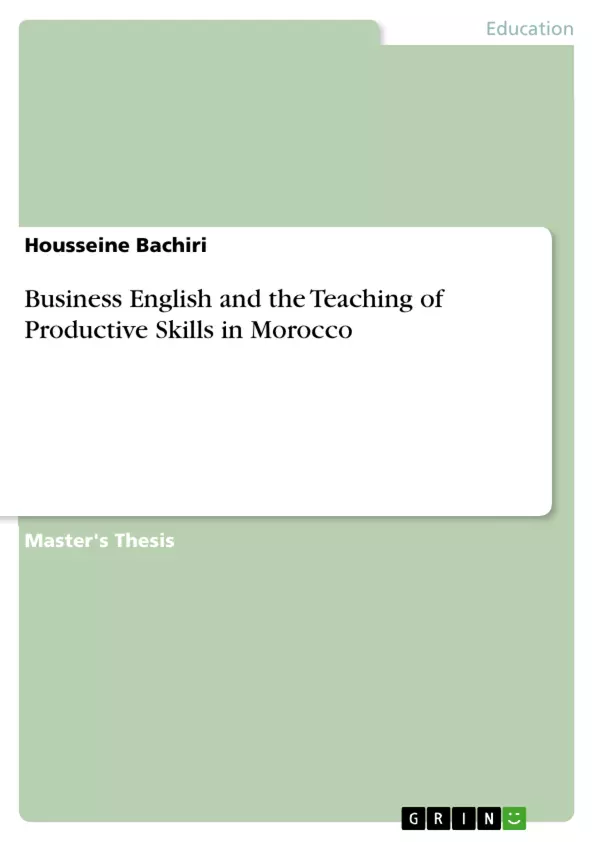The objective of the present paper is to investigate problems concerned with the teaching of productive skills in Business English classes. Productive skills refer to speaking and writing. Business English is a branch of English for Specific Purposes (ESP).
This research project aims to investigate the attitudes and perceptions of the Ecole Nationale de Commerce et de Gestion (ENCG) students about the productive skills in the ESP course, as well as to figure out whether the ENCG students are fully aware of the significance of productive skills in their prospective professional communication.
This paper strives to answer the following questions: What are the general features which appear to characterize the teaching of oral skills in the ESP course? Does writing in the ESP course enable students to become good English business writers? And to what extent do speaking and writing prepare ESP students for professional communication?
Inhaltsverzeichnis (Table of Contents)
- General Introduction-
- Part I: REVIEW OF THE LITERATURE
- 1.0 Introduction
- 1.1 ESP: Preliminaries
- 1.1.1 Definitions--
- 1.1.2 ESP Development
- 1.1.3 ESP: Categories and Sub-categories
- I.1.3.1 Main Categories ----
- 1.1.3.2 Business English
- 1.1.4 Speaking versus Writing
- 1.1.4.1 Differences between speaking and writing
- 1.1.5 The ESP Teacher --
- 1.2 Approaches and Types of Language Syllabi
- 1.2.1 Communicative Approach
- 1.2.2 A learning-centered Approach
- 1.2.3 Structural Syllabus
- 1.2.4 Functional-notional Syllabus·
- 1.2.5 Conclusion
- 2. Beyond the sentence: rhetorical or discourse analysis
- 4. Skills and strategies
- 5. A learning-centered approach--
- Part II: DATA COLLECTION METHODOLOGY --
- II. 1 Introduction
- II.2 Description of target population
- 11.3 Classroom Observation
- II.4 The Research Instrument
- II.4.1 Advantages of the Questionnaire
- II.4.2 The Questionnaire
- II.2: Data Classification and Analysis ·
- II.2.1 The informants----
- II.2.1.1 Background information
- II.2.3 Needs and purpose
- II.2.4 Deficiency needs ·
- II.2.1 The informants----
Zielsetzung und Themenschwerpunkte (Objectives and Key Themes)
This research project investigates the teaching of productive skills in Business English within the Moroccan educational context. It examines the current state of Business English education, analyzes the needs and expectations of students, and explores potential improvements in pedagogical approaches.
- The role of English for Specific Purposes (ESP) in Business English education.
- The challenges and opportunities of integrating productive skills (speaking and writing) into Business English courses.
- The importance of a learning-centered approach and incorporating students' needs and perspectives in designing effective teaching methodologies.
- Exploring the impact of communicative and structural syllabi on language acquisition and development.
- Identifying specific needs and deficiencies in the teaching and learning of Business English in Morocco.
Zusammenfassung der Kapitel (Chapter Summaries)
The first chapter provides a comprehensive overview of English for Specific Purposes (ESP), focusing on its definitions, development, categories, and subcategories, with particular emphasis on Business English. It delves into the differences between speaking and writing in Business English and discusses the role of the ESP teacher. The chapter concludes by examining different approaches and types of language syllabi, including the Communicative Approach, a learning-centered approach, the Structural Syllabus, and the Functional-Notional Syllabus.
The second part of the research project focuses on the data collection methodology. It outlines the target population, describes classroom observation practices, and details the research instrument used, which is a questionnaire. The chapter also discusses the advantages of using a questionnaire for data collection and provides a detailed explanation of the questionnaire itself. Additionally, it outlines the approach to data classification and analysis, including the informants' background information, their needs and purposes, and their perceived deficiencies in Business English education.
Schlüsselwörter (Keywords)
This research explores the key concepts of English for Specific Purposes (ESP), Business English, productive skills (speaking and writing), learning-centered approach, communicative and structural syllabi, needs analysis, and deficiencies in Business English education within the Moroccan context. It focuses on the practical application of these concepts to improve the teaching and learning of Business English in Morocco.
- Citation du texte
- Housseine Bachiri (Auteur), 2011, Business English and the Teaching of Productive Skills in Morocco, Munich, GRIN Verlag, https://www.grin.com/document/379285



